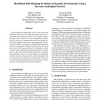Free Online Productivity Tools
i2Speak
i2Symbol
i2OCR
iTex2Img
iWeb2Print
iWeb2Shot
i2Type
iPdf2Split
iPdf2Merge
i2Bopomofo
i2Arabic
i2Style
i2Image
i2PDF
iLatex2Rtf
Sci2ools
129
Voted
ATAL
2004
Springer
2004
Springer
Distributed Path Planning for Robots in Dynamic Environments Using a Pervasive Embedded Network
We investigate the application of a low-cost, pervasively distributed network to plan paths for mobile robots in environments with dynamic obstacles. We consider a heterogeneous system composed of small, embedded, immobile, possibly sensor-less, communication nodes and larger mobile robots equipped with sensors and manipulators. We develop and analyze techniques for distributed path planning when the environment is dynamic and paths are destroyed and created. We demonstrate that the embedded network provides nearly optimal path planning without the network nodes or the robots having global knowledge or localization capabilities. A power-aware technique is presented that is able to respond to changes in the environment quickly, but concentrates network messages along the path the robot is currently using. Through simulation we analyze the communication cost and performance of the techniques.
Related Content
| Added | 20 Aug 2010 |
| Updated | 20 Aug 2010 |
| Type | Conference |
| Year | 2004 |
| Where | ATAL |
| Authors | Keith J. O'Hara, Tucker R. Balch |
Comments (0)

